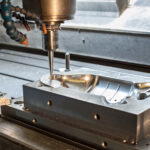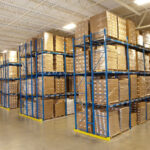When it comes to your warehouse, optimizing available square footage is key. This isn’t just important for aesthetic or functional purposes, but also helps to ensure safety in this area, as well.
Why Use Pallet Racking?
Before we begin, let’s delve into the benefits of implementing a pallet racking system in your warehouse. With so many storage solutions at your fingertips, what makes this one a top way to go? Put simply, it checks off the major criteria needed at this juncture: it’s cost-effective, efficient, and safe. Moreover, the framework design enables any worker to access pallet at any point, improving maneuverability. It’s also convenient, as vertical storage is a safe-saver and allows you to pack more inventory into your warehouse. Indirectly, this can lead to growth in sales, as you’ll have more room than ever to store products. Managers looking to transform their warehouse organization with a warehouse racking design should take a few steps to ensure a successful setup:
1. Understand Rack Weight
Overloading your pallet poses a physical threat to your safety, as one that is not properly supported can tip over and fall inward on itself. On the other hand, underloading can waste valuable storage capacity. This is why it’s important to understand the limits at each end of the spectrum. Post the weight limit for each pallet rack in the warehouse for all employees to see. This helps them understand how much to load and unload. As a rule of thumb, the bottom portion of the pallet is reserved for heavier loads. Using rack uprights? Make sure they’re able to support your heaviest load to avoid the risk of collapse.
2. Prioritize Even Distribution
Especially to a new employee, it may seem as though the pallet is secure as long as the entire load is placed somewhere on it. Yet, experienced employees know that the load has to be evenly distributed, as even the smallest shift in weight can upset the equilibrium, tipping the entire thing over. This is where warehouse training is key. It’s smart to ensure that everyone involved in the pallet racking process is well-versed in safe forklift operations. The Occupational Health and Safety Administration (OSHA) cites that forklift accidents cause more than 96,000 injuries per year, ranging from non-serious to fatal. Make sure everyone in charge of loading the pallet knows how to operate the equipment and how to strategically place the items. Managers can also hold training around the racks themselves, covering such topics as maintenance and operation.
3. Utilize ERP Software Resources
Are your warehouse pallet racks loaded down with inventory? If so, keeping up with it all can be a daunting task, especially via manual means. Today, Enterprise Resource Planning (ERP) software solutions are available to help automate the process. With an ERP solution, workeres can better keep track of orders, which minimizes stock search time and amplifies productivity.
4. Make Repairs & Replacements
A broken bearn might look fine from the outside, but actually be structurally unsound. Never assume it’s still operational. Instead, repair or replace it immediately. Think of the beams that comprise the rack as a set of dominoes. If one falls, the rest do too. Take the time to switch out damaged beams for sturdier ones as the need arises. Why? The integrity of your racking solution depends on it. A fractured beam may look fine at the onset, but as soon as you begin to load the parts it’s required to organize, you’ll quickly realize its ineffectiveness. Routine maintenance will cost less in the long run than replacing an entirely unusable rack. Make it a practice to regularly inspect all pallets for signs of disrepair and post a checklist of steps to take when these issues arise.
5. Let The Pallets Breathe
When setting up your pallet rack design, dont place a pallet beside a wall, even if you’re trying to save space. If you do, you’re rendering a portion of the rack inaccessible. Rather, ensure that each one is accessible all the way around. This is important for manual inspection as well as forklift operations. Make sure the aisle width on either side of the pallet is the same so employees can access and serve each area uniformly.
Does a warehouse pallet racking solution sound like the ideal way to give some square footage back to your warehouse, streamline operations and improve worker productivity?
The benefits are enormous and the setup is seamless, but you may not know how to design this type of system for your space. We’d love to help.
Our storage consultants will analyze your warehouse needs and provide a comprehensive pallet storage approach catered to your space, budget and intended use. From single selective racking to cantilever racking, we do it all.
Contact us today to get started and let’s transform your workspace together





